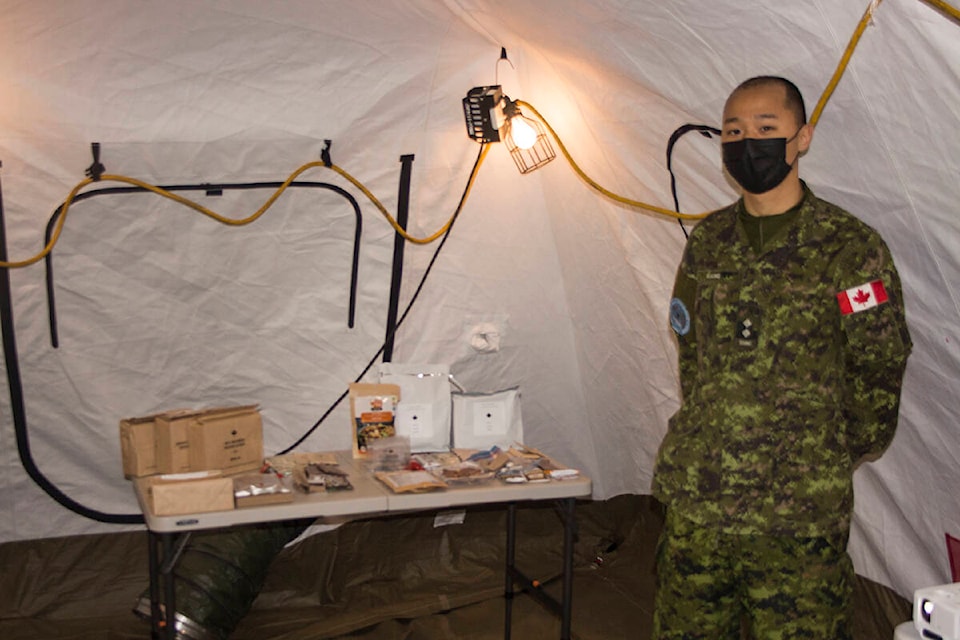Anyone who’s worked a tough job on an empty stomach knows just how important a good, balanced meal can be.
When it comes to defending Canada’s sovereignty in the far North, that’s no exception.
“It’s a great opportunity for us, we’ve kind of piggybacked on the operation,” said bio-science officer Lt. Richard Kang, who field-tested a new type of field ration during the Canadian Armed Forces’ (CAF) Operation Nanook-Nunalivut, which ran from Feb. 14 to 28 in the Beaufort Delta. “This trial is going to help us find out whether the troops themselves agree with the contents and like what they’re seeing, and if it’s something that works in this kind of environment.
“The one thing about the Arctic is there is a lot more expenditure of energy — a lot more heat production the body needs. As a result, there is a requirement for more calories, so one of the things we would like to see is if 5,000 calories is enough.”
Called the Mountain Cold Weather Ration (MCWR), the new style of ration is freeze-dried and freeze-proof.
With both a control group using the traditional rations and a second group of 48 soldiers from the Winnipeg Rifles battalion testing the new offering, Kang said the goal was to see if there were any unforeseen effects from using the newer rations in the North.
Aside from ensuring soldiers are getting enough protein, carbohydrates and fat, a key factor in designing the new rations is the calorie count, as keeping warm in -40 C windchills takes substantially more energy than it would at more temperate climes. They are designed to provide at least 3,600 calories of energy per day, a daily protein content of 118 to 185 grams, 404 to 584 grams of carbohydrates and 54 to 140 grams of fat.
Kang said there were a number of reasons for soldiers to carry their own rations. First, it removes the need to forage, which can give away a unit’s position and also leave permanent damage to the landscape.
Second, by using artificial means to heat the food, soldiers can avoid making a fire to cook their meals, which means no smoke appearing over the horizon to onlookers. The new rations are a marked improvement over the traditional combat rations, which were first developed as Individual Meal Packs (IMP) in 1983. These are sterilized by high temperatures and can last for up to three years, thus are able to be taken into the field.
“So the aim of the MCWR is to provide CAF soldiers with an alternative to the IMP, which was found to be not as effective in the Arctic environment,” said Kang. “Hearing from feedback, what troops really wanted was something they can snack on over the day, then in the evening when they’re most likely in a campsite, they will be able to then have a nice hot meal, which requires some boiling water to reconstitute one of our freeze-dried products.
“In the evenings, troops will most likely be setting up tents. They will be inside and able to boil water.”
Daytime snacks include granola and protein bars to keep energy levels up.
With the operation wrapped up March 10, Kang said he would take his research back to Defence Research Development Canada to crunch the numbers.
If the rations turn out to be more efficient, soldiers on the front lines could be eating them as soon as 2024.
Developing new combat rations is a three-year process, beginning with product development, trials, developing specific menus and then moving forward to production. The military develops about 21 new IMPs each year, including rations for special dietary considerations such as vegetarian, kosher and halal diets. Rations are further divided into specialized categories such as light meal combat rations and survival rations.
“(It’s) basically a small, starch gummy,” Kang said of the survival fare. “It’s really only used in emergency situations and it’s often used in a CAF aircraft, just in case there was an emergency landing.”
